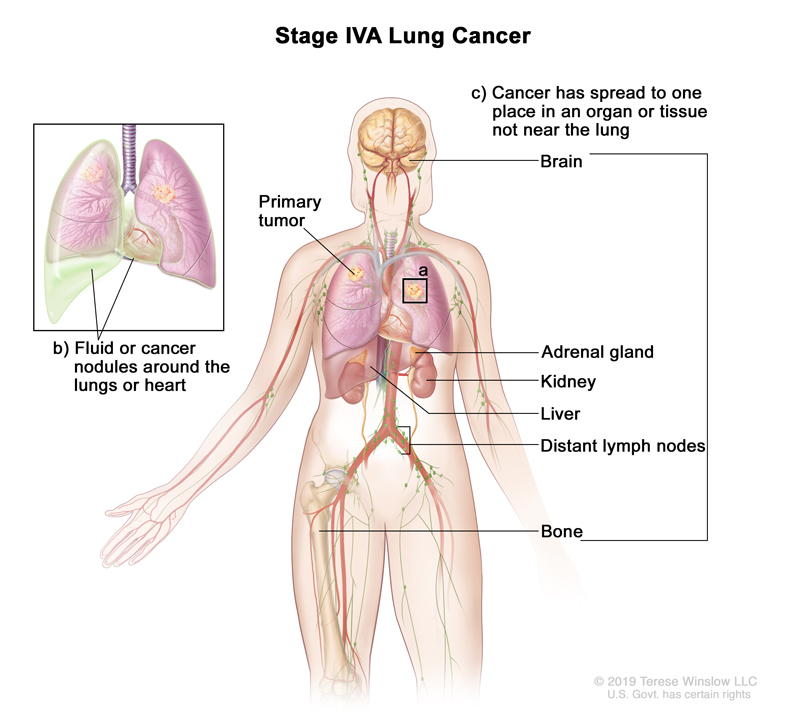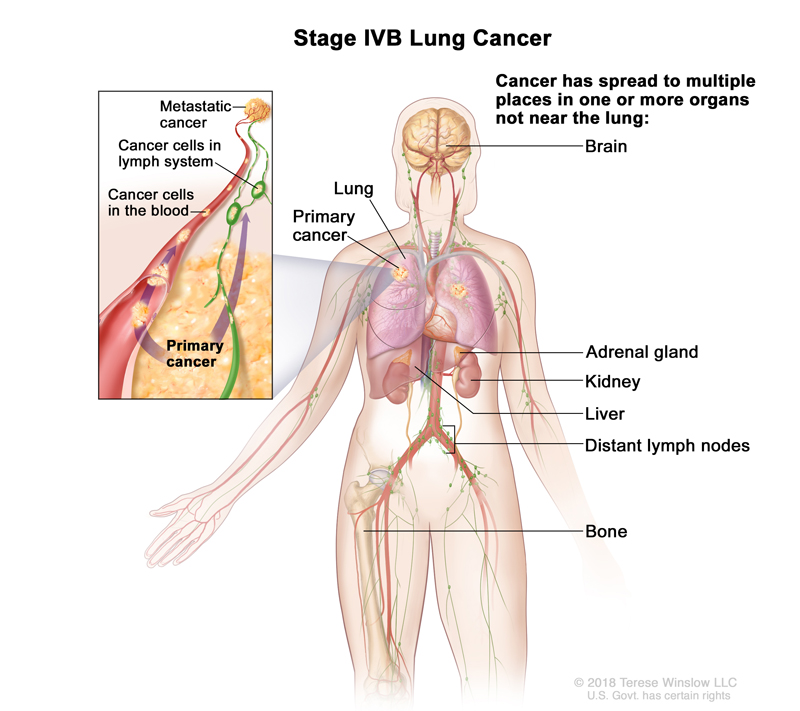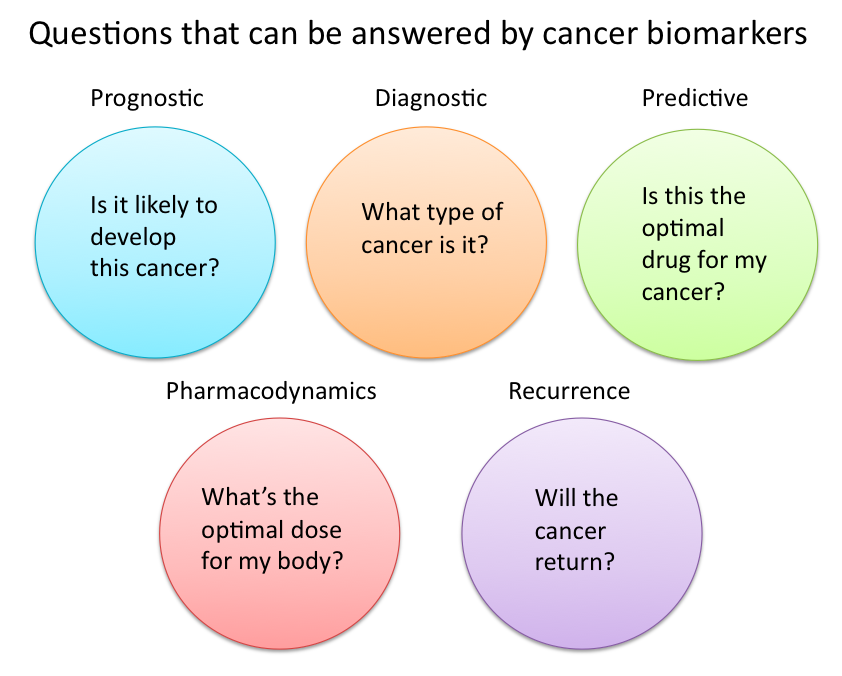Stage 4 Non-Small Cell Lung Cancer (NSCLC) is the most advanced stage of Lung Cancer and is divided into Stage 4A and Stage 4B.
Tap “Watch Now” for an easy-to-understand overview of a Stage 4 Non-Small Cell Lung Cancer diagnosis including the most common biomarkers.; then compare treatment options side-by-side.
- Stage 4A Lung Cancer
- Stage 4B Lung Cancer
- KRAS, EGFR, MET, ALK, BRAF, PD-L1..
Overview
Stage 4A Non-Small Cell Lung Cancer diagnosis is when the tumor is any size and one or more of the following has happened:
- There are tumors in the opposite lung.
- There are tumors in the inner lining of the lungs or the heart.
- There are cancer cells found in liquid in your lungs or heart (pleural or pericardial effusion).
- There is one tumor outside your chest in one other organ, such as bone, liver, brain, etc.
What Tests Will I Need and Why?
Blood and Imaging tests are done to understand your general health, confirm your diagnosis and determine your cancer stage.
Tissue analysis is also typically done to determine if the cancer cells have any specific biomarkers which are critical to finding the best treatment option for you.
In Stage 4 NSCLC, doctors look for many different biomarkers, including: ALK, EGFR, KRAS, ROS1, BRAF, NTRK, MET, RET and PD-L1. Identifying a specific biomarkers can help determine which treatment option will be more effective against the cancer and get better results.
Nearly 50% of NSCLC patients will test positive for one type of biomarker. If your treatment team has not already performed tests to determine your cancer’s features, please ask your doctor when these tests will be performed.
Re-read this summary as needed and then tap, “Compare My Treatment Options Now“. Our unique Comparison Page will help you understand your FDA-approved treatment options including, who can help you pay for your treatment, where and how each is given and what side-effects you may experience.

National Institute of Health/ treatment-lung
Overview
Stage 4B Non-Small Cell Lung Cancer diagnosis is when the lung cancer has spread from your lung to multiple organs in your body that are not near your lungs.
The other organs often affected by Stage 4B Non-Small Cell Lung Cancer are the kidney, adrenal gland, brain, liver, or bones as shown here. Please ask your doctor where exactly the cancer has been found in your body.
What Tests Will I Need and Why?
Blood and Imaging tests are done to understand your general health, confirm your diagnosis and determine your cancer stage.
Tissue analysis is also typically done to determine if the cancer cells have any specific biomarkers which are critical to finding the best treatment option for you.
In Stage 4 NSCLC, doctors look for many different biomarkers, including KRAS, EGFR, ALK, ROS1, BRAF, NTRK, MET and PD-L1. Identifying a specific biomarkers can help determine which treatment option will be more effective against the cancer and get better results.
Nearly 50% of NSCLC patients will test positive for one type of biomarker. If your treatment team has not already performed tests to determine your cancer’s features, please ask your doctor when these tests will be performed.

National Institute of Health/ treatment-lung
Identifying your biomarker is critical to determining the best treatment option for you
In addition to the size and cancer stage, your treatment options are guided by biomarkers that can be identified in patients with NSCLC. Below is a summary of the most common biomarkers.
KRAS-positive
KRAS is a protein found in your normal cells helps with your body’s cell growth. When there is a mutation (an abnormal change in your cell’s DNA) in KRAS, it causes excessive cell division and cancer.
20-25% of NSCLC patients have a KRAS mutation.
Compare My KRAS-Positive Treatment Options Now
EGFR-positive
EGFR (Epidermal Growth Factor Receptor) is a protein that helps your body with healthy cell growth. A mutation or abnormal change in your body’s EGFR gene can cause excessive cell growth and cancer.
10-15% of NSCLC patients have an EGFR mutation.
There are different types of EGFR mutations that doctors look for including EGFR 19 deletion, EGFR L858R and EGFR exon 20 insertion. EGFR L858R is the most common type.
Compare My EGFR-positive Treatment Options Now
MET-positive
MET is both a protein and a gene. There can be mutations (errors) found in the MET protein or extra copies of the MET gene called amplification, which would cause excessive cell division and tumor growth.
~5% of NSCLC patients are MET-positive. MET exon 14 skipping is the most common MET error found.
Compare My MET-positive Treatment Options Now
ALK-positive
ALK (Anaplastic Lymphoma Kinase) gene is found in your cells before you are born and should automatically be turned off before birth. In some people, it turns back on and joins another gene, this change is called ALK fusion or ALK rearrangement and can cause cancer.
About 4% of patients with Lung Cancer are ALK-positive.
Compare My ALK-positive Treatment Options Now
BRAF-positive
The BRAF protein controls how fast cells grow. When there is a mutation, an abnormal change in your cell’s DNA in the BRAF gene, it causes accelerated cell growth and cancer.
~ 4% of patients with NSCLC are BRAF-positive, and those patients tend to have a smoking history.
Compare My BRAF V600E Treatment Options Now
HER2-positive
HER2 is a protein that is found in normal cells, it gives them a signal to grow and produce more cells. A HER2-positive NSCLC means that the tumor cells have too many HER2 proteins, causing uncontrolled tumor growth and cell division.
About 2% of patients with NSCLC are HER2-positive.
NTRK-positive
NTRK can join other genes, which would be called NTRK gene fusion. This union of genes can cause uncontrolled cell division and tumor growth.
Less than 1% of NSCLC patients test NTRK-positive.
Compare My NTRK-positive Treatment Options Now
PD-L1 >50%
PD-L1 is a protein that is found in healthy cells and acts as a “brake” to keep your immune system from attacking your body’s non-harmful cells. Some cancer cells “trick” the immune system to not turn on and therefore avoid being attacked.
If your tests show cancer cells with a high level of PD-L1 ( > than 50% of the cells have PD-L1), you may benefit from immunotherapy, a treatment type that takes the “brakes” off your immune system so it will recognize and attack the cancer.
Compare My PD-L1 >50% Treatments Now
RET-positive
RET is a gene that can join to other genes in patients with NSCLC. This union is called RET rearrangement or RET fusion and causes rapid cell division and tumor growth.
1-2% patients with NSCLC test RET-positive
Compare My RET-positive Treatment Options Now
ROS1-positive
ROS1 is a gene that can join to other genes in patients with NSCLC. This union is called ROS1 rearrangement or ROS1 fusion and causes rapid cell division and tumor growth.
1-2% patients with NSCLC test ROS1-positive. These patients tend to be diagnosed at an earlier age and have little to no smoking history.

K.go2011, CC BY-SA 3.0
Recommended Lung Cancer Videos

Understanding the Stages of Lung Cancer
Stages 1 thru Stage 4

ASK! Will Mutation Testing Help Find The Best Treatment For Me?
Knowing May Show What Drugs Will Work & What Won't!

Diagnosing Your Cancer
How Does a PET Scan Work?

Attitude Really Matters
Get Inspired by Ann
Commonly Searched Questions
Stage 4 Non-Small Cell Lung Cancer Symptoms
The symptoms of Stage 4 lung cancer are dependent on the part of the body that is affected.
These are some common symptoms that you might experience if you have Stage 4 lung cancer.
- Breathlessness
- Chronic cough
- Feeling weak
- Coughing up blood
- Weight loss
- Chest pain
- Noisy breathing
- Difficulty in swallowing
- Paraneoplastic syndrome
- Horner’s Syndrome(drooping of the eyelid and absence of sweating on one side of the face)
Source: Cancer.org
Stage 4 Non-Small Cell Lung Cancer Treatment
These are some common treatment options that are available for your Stage 4 lung cancer.
- Surgery: This involves removing part of the lung or a whole lobe of the lung that is affected
- Chemotherapy: can be given before or after surgery
- Targeted Therapy: targets the changes or mutations in cancer cells that help them grow, divide and spread
- Immunotherapy: helps a person’s immune system identify and kill cancer, often in combination with or without chemotherapy.
- Radiotherapy
Now Click Here To Compare Your Latest Treatment Options.
Source: Cancer.org
Stage 4 Non-Small Cell Lung Cancer Survival Rate
According to SEER data, Stage 4 lung cancer falls into the distant Stage with a survival rate of 6.3%. This means that people with Stage 4 lung cancer are 7% as likely as people without lung cancer to live for 5 years after the diagnosis.
These numbers do not take into account recurrence (cancer coming back), non-small cell lung cancer subtypes and newer data so they should be used with caution.
Source: Cancer.gov
Stage 4 Non-Small Cell Lung Cancer Recurrence Rate
The chance of your Stage 4 lung cancer coming back (recurrence rate) is influenced by multiple factors such as your overall health, the type of treatment used and your genetics.
There are limited studies on the recurrence rate of Stage 4 lung cancer. Please talk to your doctor about your specific situation.
Source: PubMed.gov
Stage 4 Non-Small Cell Lung Cancer Definition
Stage 4 non-small cell lung cancer (NSCLC) is the most advanced stage of lung cancer. In stage 4 NSCLC, the cancer has spread beyond the lung in which it originated to other parts of the body. This typically includes distant organs such as the liver, bones, adrenal glands, brain, or distant lymph nodes. Stage 4 NSCLC is also referred to as metastatic lung cancer because the cancer cells have spread through the bloodstream or lymphatic system to establish new tumors in these distant locations.
Source: Cancer.org
Stage 4 Non-Small Cell Lung Cancer Prevention
Specific prevention strategies for Stage 4 Non-Small Cell Lung Cancer (NSCLC), which is advanced and has spread beyond the lungs, are not provided. However, general recommendations to reduce the risk of developing lung cancer and to support overall lung health include:
- Avoid Smoking: The most effective way to prevent lung cancer is to not smoke. If you currently smoke, quitting as soon as possible significantly lowers your risk.
- Avoid Secondhand Smoke: Minimize exposure to secondhand smoke, which can increase lung cancer risk.
- Reduce Exposure to Carcinogens: Limit exposure to known carcinogens such as asbestos and radon. Ensure proper ventilation and use protective equipment if you work with hazardous substances.
- Healthy Diet: Maintain a diet rich in fruits and vegetables to support overall lung health.
- Regular Exercise: Engage in regular physical activity to promote overall health.
- Screening for High-Risk Individuals: For individuals at high risk, such as long-term smokers, regular low-dose CT screenings can help detect lung cancer early.
Source: Cancer.org















